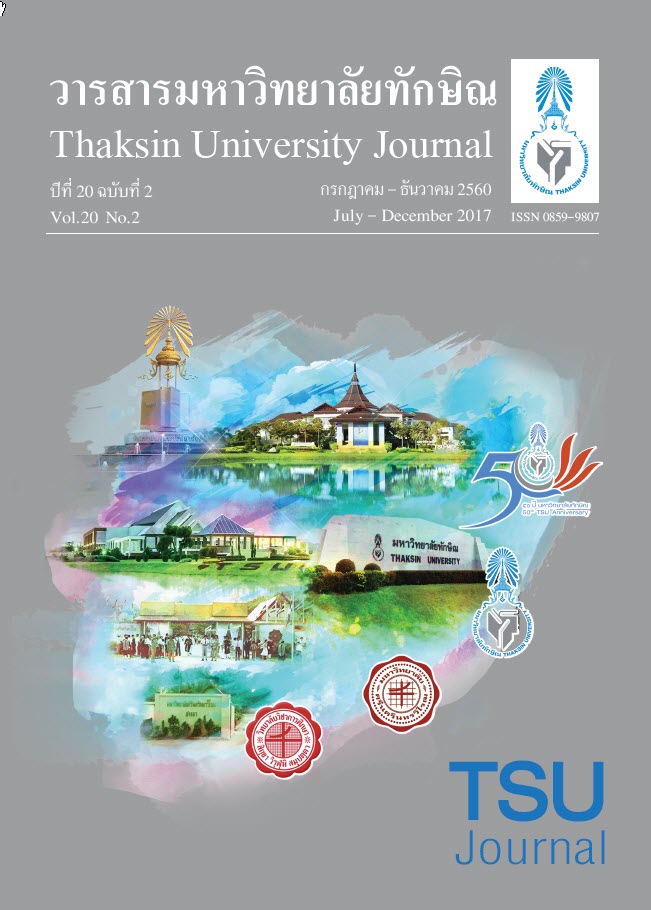การศึกษาองค์ประกอบทางเคมีของผลปาล์ม (Elaeis guineensis) หลังการเก็บเกี่ยว และการประยุกต์ใช้ไลเปสจากปาล์มในการผลิตไบโอดีเซล
Main Article Content
บทคัดย่อ
เมื่อนำผลปาล์มหลังการเก็บเกี่ยวที่ 0 ชั่วโมงมาสกัดด้วยเมทานอลจะให้สารสกัดหยาบสูงสุด คิดเป็นค่าประสิทธิภาพการสกัด 21.64 เปอร์เซ็นต์ ในสารสกัดเมทานอลจากผลปาล์มหลังการเก็บเกี่ยว 0 ชั่วโมงจะพบสารกลุ่มซาโปนิน ฟีนอล และแทนนินในปริมาณสูง เมื่อวิเคราะห์องค์ประกอบทางเคมีหลังการเก็บเกี่ยวของผลปาล์ม 0-240 ชั่วโมง พบว่า ปริมาณสารฟีนอลิก วิตามินอี โปรตีน และแคโรทีน จะลดลงตามระยะเวลาการเก็บเกี่ยวที่เพิ่มขึ้น ในขณะที่กิจกรรมของไลเปสจะค่อย ๆ เพิ่มขึ้น โดยจะมีกิจกรรมของเอนไซม์สูงสุดที่ 120 ชั่วโมง เมื่อนำไลเปสมาแยก และทำบริสุทธิ์บางส่วนพบว่ากิจกรรมของเอนไซม์จะเพิ่มเป็น 4.76 ยูนิต/มิลลิกรัม ไลเปสจากผลปาล์มจะถูกนำมาใช้เป็นตัวเร่งในการผลิตไบโอดีเซลโดยมีน้ำมันใช้แล้วเป็นสารตั้งต้น จากการทดลองพบว่าการใช้เอนไซม์ทำบริสุทธิ์บางส่วนในการผลิตไบโอดีเซล ปฏิกิริยาจะให้ผลผลิตสูงสุดที่ 6 ชั่วโมง ซึ่งใกล้เคียงกับการเร่งปฏิกิริยาด้วยไลเปสทางการค้า ในขณะที่การใช้สารสกัดหยาบของเอนไซม์จะใช้เวลาสูงกว่า (12 ชั่วโมง) ผลผลิตไบโอดีเซลที่ได้มีปริมาณเมทิลเอสเทอร์เท่ากับ 96.5-98 เปอร์เซ็นต์ และคุณสมบัติของไบโอดีเซลจากการทดลองนี้ยังผ่านมาตรฐานกรมธุรกิจพลังงาน และมาตรฐาน American Society for Testing and Materials (ASTM)
Article Details
References
composition, morphological characteristics, and cell wall structure of Malaysian oil palm fibers”,
Polymer-Plastics Technology and Engineering. 47, 273-280.
[2] Kok, S., Ong-Abdullah, M., Ee, G.C. and Namasiyayam, P. (2011). “Comparison of nutrient composition in
kernel of tenera and clonal materials of oil palm (Elaeis guineensis Jacq.)”, Food Chemistry. 129, 1343-1347.
[3] Edem, D.O. (2002). “Palm oil: biochemical, physiological, nutritional, hematological and toxicological aspects:
a review”, Plant Foods for Human Nutrition. 57, 319-341.
[4] Ahmad, A.L., Chan, C.Y., Abd Shukor, S.R. and Mashitah, M.D. (2008). “Recovery of oil and carotenes from
palm oil mill effluent (POME)”, Chemical Engineering Journal. 141, 383-386.
[5] Rhein, M. (2014). Industrial Oil Palm Development : Liberia’s Path to Sustained Economic Development
and Shared Prosperity Lessons from the East. Washington, DC: Rights and Resources Initiative.
[6] Yin, N.S., Abdullah, S. and Phin, C.K. (2013). “Phytochemical constituents from leaves of Elaeis guineensis
and their antioxidant and antimicrobial activities”, International Journal of Pharmacy and
Pharmaceutical Science. 5, 137-140.
[7] Konate, K., Souza, A., Therese, K.Y., Dibala, I.C., Barro, N., Millogo, R.J. and Nacoulma, O.G. (2011).
“Phytochemical composition, antioxidant and anti-inflammatory potential of bioactive fractions from
extracts of three medicinal plants traditionally used to treat liver diseases in Burkina Faso”, International
Journal of Phytomedicine. 3, 406-415.
[8] Razavi, S.M.A. and Taghizadeh, M. (2007). “The specific heat of pistachio nuts as affected by moisture content,
temperature and variety”, Journal of Food Engineering. 79, 158–167.
[9] Teixeira, C.B., Macedo, G.A., Macedo, J.A., Da Silva, L.H.M., Da, C. and Rodrigues, A.M. (2013).
“Simultaneous extraction of oil and antioxidant compounds from oil palm fruit (Elaeis guineensis) by
an aqueous enzymatic process”, Bioresource Technology. 129, 575-581.
[10] AOAC. (1990). Official Methods of the Association of Official Analytical Chemists (14th ed). Washington, DC.
[11] Schieber, A., Marx, M. and Carle, R. (2002). “Simultaneous determination of carotenes and tocopherols in
ATBC drinks by high-performance liquid chromatography”, Food Chemistry. 76, 357-362.
[12] Kimtun, P., Choonut, O., Yunu, T., Paichid, N., Klomklao, S. and Sangkharak, K. (2015). “Biodiesel production
using lipase from oil palm fruit as a catalyst”, Energy Procedia. 79, 822-826.
[13] Bouhlali, Ed.T., Alem, C., Ennassir, J., Benlyas, M., Mbark, A.N. and Zegzouti, Y.F. (2015). “Phytochemical
compositions and antioxidant capacity of three date (Phoenix dactylifera L.) seeds varieties grown in
the South East Morocco”, Journal of the Saudi Society of Agricultural Science. In pressed, available
online 11 November 2015, from http://dx.doi.org/10.1016/j.jssas.2015.11.002.
[14] Chen, Y., Xiao, B., Chang, J., Fu, Y., Lv, P. and Wang, X. (2009). “Synthesis of biodiesel from waste cooking
oil using immobilized lipase in fixed bed reactor”, Energy Conversion and Management. 50(3), 668-673.
[15] Eloff, J.N. (1998). “Which extractant should be used for the screening and isolation of antimicrobial components
from plant?”, Journal of Enthnophamacology. 60(1), 1-8.
[16] Atchley, A.A. (1984). “Nutritional value of palms”, Principles. 28, 138-143.
[17] Dai, J. and Mumper, R.J. (2010). “Plant phenolics: extraction, analysis and their antioxidant and anticancer
properties”, Molecules. 15, 7313–7352.
[18] Amira, E.A., Behija, S.E., Beligh, M., Lamia, L., Manel, I., Mohamed, H. and Lotfi, A. (2012). “Effect of
the ripening stage on phenolic profile, phytochemical composition and antioxidant activity of date palm
fruit”, Journal of Agricultural and Food Chemistry. 60, 10896-10902.
[19] Ong, H.C. (2004). Tumuhan liar. Khasiat Ubatan Dan Kegunaan Lain. Utusan Publication and Distributor,
Kuala Lumpur.
[20] Neo, Y.P., Ariffin, A. and Tan, C.P. (2010). “Phenolic acid analysis and antioxidant activity assessment of
oil palm (E. guineensis) fruit extract”, Food Chemistry. 122, 353-359.
[21] Bruice, T.C. and Benkovic, S.J. (2000). “Chemical basis for enzyme catalysis”, Biochemistry. 39, 6267-6274.
[22] Ajayi, O.E., Awala, S.I., Ogunleye, A.G. and Okogbue, F.N. (2016). “Antimicrobial screening and
phytochemical analysis of Elaeis guineensis (Ewe Igi Ope) against Salmonella strains”, British Journal
of Pharmaceutical Research. 10(3), 1-9.

